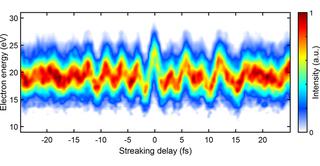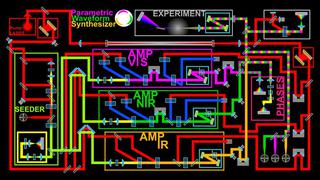Synthesis of optical waveforms promises a “brighter” future for attosecond science
An international team, with scientists from Massachusetts Institute of Technology (MIT Boston), Politecnico di Milano, University of Hamburg and CFEL/DESY, has synthesized ultrashort and intense flashes of light, so called "optical waveforms". Their duration of a few attoseconds is less than the time required by the light wave to complete a single oscillation cycle. Moreover the optical waveforms with non-sinusoidal shape can be tailored in the generation process. These achievements in ultrafast laser technology are paving the way to customizable light flashes in the whole optical range and will enable novel experiments in the attosecond regime. All findings were published in the current issue of Nature Photonics.
Attosecond streaking and extracted waveform. Measured attosecond streaking trace of the synthesised waveform, acquired with 200 as delay step size over 10 minutes (Credit: Original Publication in Nature Photonics).
The particular approach to "sub-cycle" waveform synthesis pursued here relies on a process called "optical parametric amplification", that allows to generate ultrashort pulses tunable from the ultraviolet (UV) to the mid-infrared (mid-IR) spectral region. Moreover, the parametric amplification can be cascaded to achieve even higher pulse energies. Therefore, the applied parametric synthesis appears to be the most promising approach to the generation of sub-cycle optical waveforms with scalable bandwidth energy and average power.
"Synthesized optical waveforms are expected to bring tremendous advantages in the control of strong-field light-matter interactions. In this case the electromagnetic field of light is strong enough to counteract the forces that bind electrons and nuclei and to drive the released electrons along a particular trajectory" explains Giulio Maria Rossi, CFEL scientist at DESY and the University of Hamburg. "We have shown that sub-cycle optical waveforms can be used to directly generate isolated attosecond pulses, probably the shortest events that human technology can currently create, via the strong-field high-harmonic generation process".
The possibility to shape the electric field is expected to allow overcoming the limitations in terms of conversion efficiency and cut-off extension intrinsic to the high-harmonic process, therefore enabling brighter attosecond pulses reaching up to higher photon energies. Moreover, by controlling the electron trajectories it will also be possible to control the central energy in a continuous way, as well as the bandwidth and the chirp of the attosecond pulses. These advances are expected to further advance attosecond science by making it easier to conduct attosecond measurements e.g. in the water window in the soft-X-ray region.
Optical scheme of the parametric waveform synthesizer (Credit: Original Publication; slightly changed colours).
"The parametric waveform synthesis can be transferred to different pump laser technologies allowing to reach much higher energies and average powers compared to what demonstrated here" adds Franz Kärtner, lead scientist at DESY and professor at the University of Hamburg. “This could allow exploring the impact of custom tailored waveforms to relativistic strong-filed processes such as laser-plasma wakefield acceleration”.

